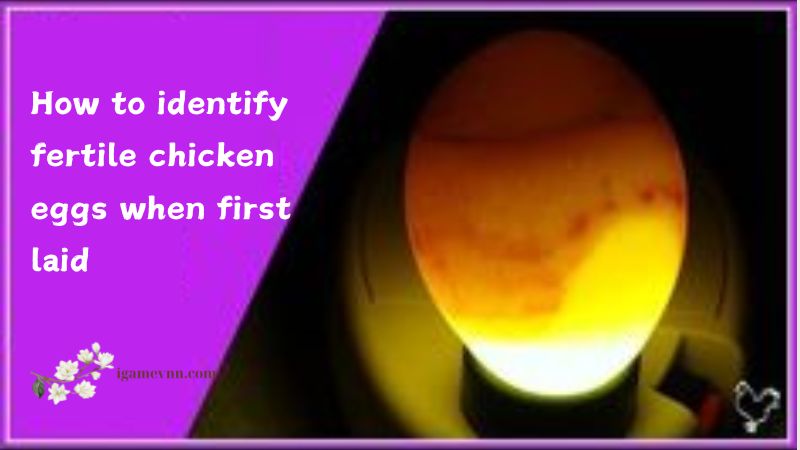Raising chickens can be a rewarding endeavor, providing fresh eggs and a unique connection to nature. For those looking to breed chickens, understanding how to identify fertile chicken eggs when first laid is crucial. Fertility in eggs ensures successful hatching and a sustainable flock. This detailed guide from Igamevnn will cover various methods and tips to help you discern fertile eggs from infertile ones, focusing on techniques like candling, identifying the blastoderm, maintaining breeding practices, and conducting an incubation test.
Table of Contents
ToggleThe Basics of Egg Fertility
Before diving into the methods on how to identify fertile chicken eggs when first laid, it’s important to understand the basics of egg fertility. A fertile egg is one that has been fertilized by a rooster’s sperm, allowing the embryo to develop and eventually hatch into a chick. In contrast, an infertile egg will not develop into a chick, regardless of incubation.
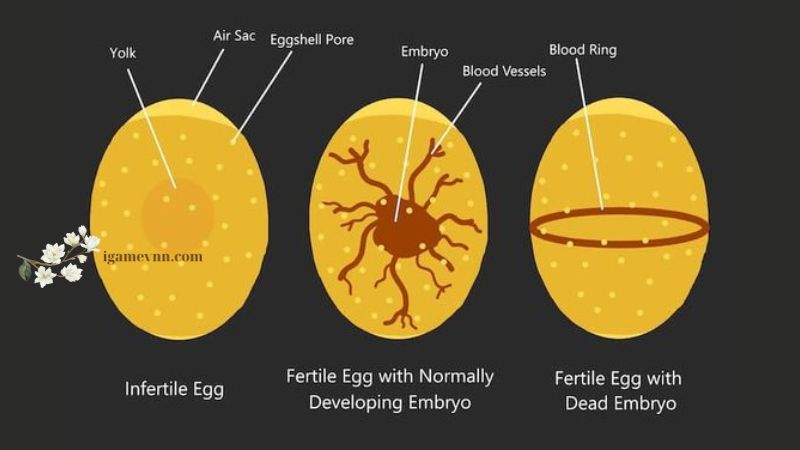
How to Identify Fertile Chicken Eggs When First Laid
1. Candling
Candling is a popular method for determining egg fertility and can be used to identify fertile chicken eggs when first laid. However, it is more effective after a few days of incubation. Here’s how to perform candling:
Timing
Candling works best after the eggs have been incubated for 5 to 7 days. Immediately after laying, it is challenging to discern fertility due to the lack of visible development.
Process
- Prepare the Equipment: You will need a bright light source, such as a candling lamp or a strong flashlight.
- Dark Room: Perform the candling in a dark room to enhance visibility.
- Hold the Egg: Hold the egg up to the light source, positioning it so that the light penetrates the shell.
- Look for Signs of Fertility: In fertile eggs, you should see signs of development, such as blood vessels or a developing embryo. Infertile eggs will appear clear, showing only the yolk shadow.
Candling can be a reliable method on how to identify fertile chicken eggs when first laid, but waiting a few days for visible signs of development is recommended for accuracy.
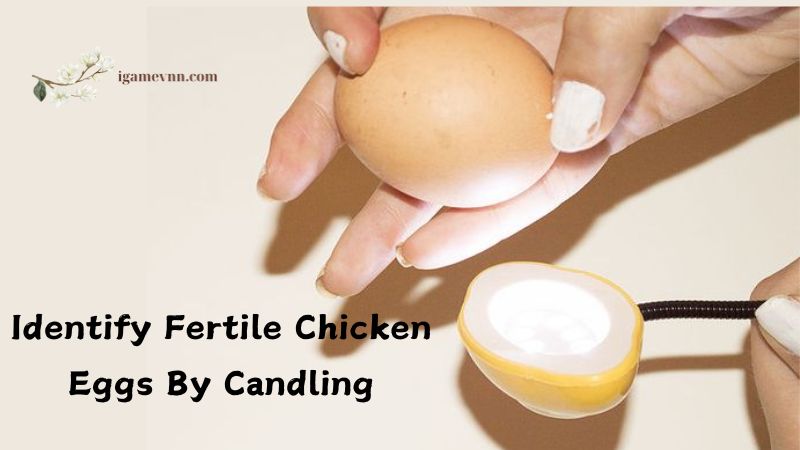
2. Blastoderm vs. Blastodisc
Another method to identify fertile chicken eggs when first laid is by examining the blastoderm or blastodisc. This method involves cracking the egg open, which means the egg cannot be incubated afterward.
Observation
- Crack the Egg: Carefully crack open a fresh egg and place the contents in a bowl.
- Inspect the Yolk: Look closely at the yolk for a small, white spot known as the germinal disc.
Fertile Egg (Blastoderm)
In a fertile egg, the germinal disc appears as a small, white spot with concentric rings, resembling a bullseye. This indicates that the egg has been fertilized and has the potential to develop into a chick.
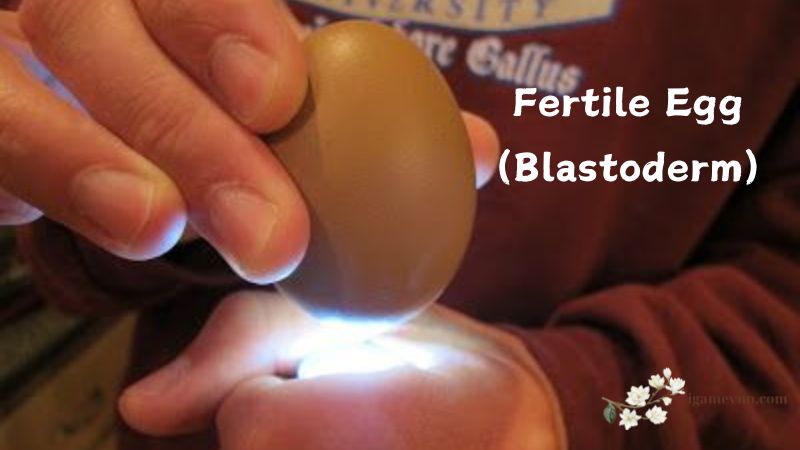
Infertile Egg (Blastodisc)
In an infertile egg, the germinal disc is smaller, more uniform, and lacks the concentric rings. This indicates that the egg has not been fertilized and will not develop into a chick.
Using this method to identify fertile chicken eggs when first laid provides immediate results, but it sacrifices the egg, making it unsuitable for those planning to incubate all their eggs.
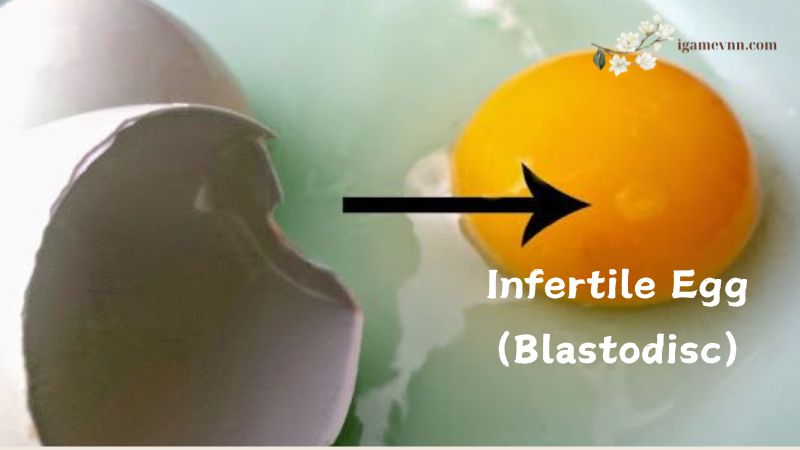
3. Breeding Practices
Ensuring a high probability of fertile eggs begins with proper breeding practices. By maintaining the right conditions and ratios in your flock, you can increase the likelihood of obtaining fertile eggs. Here are some key tips:
Rooster Presence
To ensure egg fertility, a rooster must be present in the flock. Hens can lay eggs without a rooster, but these eggs will be infertile. A healthy, active rooster will fertilize the eggs laid by the hens.
Hen-to-Rooster Ratio
Maintaining an appropriate hen-to-rooster ratio is essential for maximizing fertility. A common ratio is around 10 hens per rooster. This ensures that the rooster can effectively mate with all the hens without being overworked, which can negatively impact fertility rates.
Healthy Flock
A healthy flock is more likely to produce fertile eggs. Ensure that your chickens have a balanced diet, clean living conditions, and regular health check-ups. Stress and poor health can reduce the fertility of eggs.
Implementing these breeding practices can significantly increase the chances of obtaining fertile chicken eggs when first laid, providing a solid foundation for successful hatching.
4. Incubation Test
The incubation test is another method on how to identify fertile chicken eggs when first laid, though it requires a bit more time and patience. This method involves incubating the eggs and monitoring their development.
Incubate the Eggs
- Prepare an Incubator: Set up an incubator according to the manufacturer’s instructions, ensuring it maintains the correct temperature and humidity levels.
- Place the Eggs: Place the eggs in the incubator, making sure they are properly spaced to allow airflow.
- Monitor Development: Check the eggs periodically using the candling method.
Signs of Fertility
After a few days of incubation, fertile eggs will show signs of development when candled. You will see blood vessels and a developing embryo. Infertile eggs will remain clear or show no signs of development.
Patience is Key
The incubation test requires patience, as it takes several days to confirm fertility. However, it is a reliable method to identify fertile chicken eggs when first laid, especially when combined with candling.
Conclusion
Understanding how to identify fertile chicken eggs when first laid is crucial for successful breeding and hatching. By utilizing methods such as candling, examining the blastoderm, maintaining proper breeding practices, and conducting an incubation test, you can effectively discern fertile eggs from infertile ones. Each method has its advantages and limitations, so combining them can provide the most accurate results.
To summarize, here are the key points to remember:
- Candling: Effective after a few days of incubation, look for blood vessels and embryos.
- Blastoderm vs. Blastodisc: Examine the germinal disc for a bullseye pattern.
- Breeding Practices: Ensure a rooster is present and maintain a healthy flock with an appropriate hen-to-rooster ratio.
- Incubation Test: Incubate the eggs and monitor for signs of development.
By following these guidelines, you can confidently identify fertile chicken eggs when first laid, ensuring a successful and sustainable flock. Whether you’re a seasoned poultry farmer or a hobbyist, these techniques will help you achieve the best results in your breeding endeavors.
Related Posts:
- The World of Squash and Pumpkin: A Comprehensive Guide
- How Many Days Does it Take for a Bamboo Chicken to Hatch?
- Chickens with Dark Crests: A Detailed Overview
- The Ultimate Guide to Greenhouse Vegetable Growing
- How Long Does It Take for Chicks to Be Separated…
- Understanding Lettuce is Bitter and Managing:…

